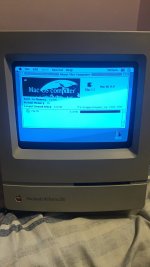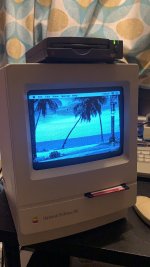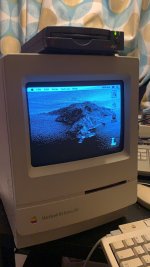jake18125
Well-known member
I'm actually amazed this worked, but I managed to get Mac OS 8 running on my Classic II! (Ok strictly speaking it is a Performa 200, but come on they are literally identical).
How did I manage this?
Well I realised that the Classic II actually has a 32 bit clean rom, so really it should be able to boot Mac OS 8 in a similar process to how SE/30s can run 8 with a clean ROM.
The only issue is the installer needs 12mb, whilst the Classic II tops out at 10mb. However, in normal operation a basic Mac OS 8 install only uses ~6mb of ram.
Therefore I only needed to follow this guide:
https://vintageapple.org/gamba2/os8_68030.html
But to get around the 12mb ram limit when installing Mac OS 8, I used my Performa 475 and an external SCSI CD drive to install it onto a Zip Drive.
I was then able to boot into Mac OS 7 on my Performa 200, make the necessary changes on the zip drive (noting that the value in GUSD that needed to be changed is the Gestalt ID, thankfully a list is provided at the bottom of the page), then use system picker to select the Mac OS 8 system file and cross my fingers.
Incredibly enough it worked! Hopefully the same method should work on other Macs that have the same ram limit.
A zip drive isn't really necessary, just so long as you have a bootable drive and a second method of editing the system files as detailed by the guide. I'm also pretty sure "wish I were" isn't necessary as you don't need to fool the installer.
However I am pretty sure you need a Macintosh with a 68040 that can boot/install Mac OS 8. If anyone wants to try it with a PPC mac please let me know how it goes!




How did I manage this?
Well I realised that the Classic II actually has a 32 bit clean rom, so really it should be able to boot Mac OS 8 in a similar process to how SE/30s can run 8 with a clean ROM.
The only issue is the installer needs 12mb, whilst the Classic II tops out at 10mb. However, in normal operation a basic Mac OS 8 install only uses ~6mb of ram.
Therefore I only needed to follow this guide:
https://vintageapple.org/gamba2/os8_68030.html
But to get around the 12mb ram limit when installing Mac OS 8, I used my Performa 475 and an external SCSI CD drive to install it onto a Zip Drive.
I was then able to boot into Mac OS 7 on my Performa 200, make the necessary changes on the zip drive (noting that the value in GUSD that needed to be changed is the Gestalt ID, thankfully a list is provided at the bottom of the page), then use system picker to select the Mac OS 8 system file and cross my fingers.
Incredibly enough it worked! Hopefully the same method should work on other Macs that have the same ram limit.
A zip drive isn't really necessary, just so long as you have a bootable drive and a second method of editing the system files as detailed by the guide. I'm also pretty sure "wish I were" isn't necessary as you don't need to fool the installer.
However I am pretty sure you need a Macintosh with a 68040 that can boot/install Mac OS 8. If anyone wants to try it with a PPC mac please let me know how it goes!




